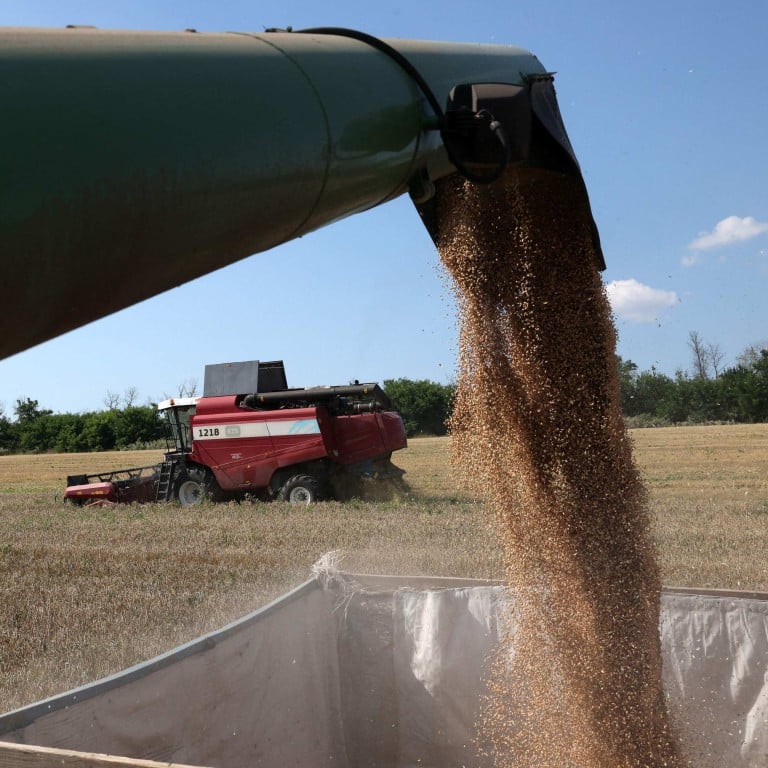
Why Russia wants a Brics grain exchange – and what it means for the world
- It would boost Russia’s influence as a vital grain supplier, provide greater food security for Brics states and potentially change the dynamics of the global agricultural market, hitting Western exporters from the US to Australia
In a move that could shake up the global agricultural market, Russia is pushing to establish a Brics grain exchange. Russian President Vladimir Putin has endorsed the initiative, which seeks to rival the Western-dominated grain pricing system and challenge the US dollar as the world’s main trading currency.
A Brics grain exchange would bring together some of the world’s biggest grain buyers and exporters. Last year, members of Brics (Brazil, Russia, India, China and South Africa) accounted for an estimated 42 per cent of global grain production at nearly 1.2 million tonnes, and 40 per cent of global consumption, according to Russia’s agricultural ministry.
Many Brics members are resource-rich countries and their top exports include crude petroleum oil (such as from Iran and the UAE), iron ore, soybeans and sugar (from Brazil), fertilisers (from Russia and China), and coffee and oilseeds (from Ethiopia). Given this abundance, a grain exchange among them could pave the way for stronger inter-regional trade or even a broader Brics commodities exchange.
Stronger cooperation among Brics nations may pave the way for stronger infrastructure development (such as storage facilities) and connectivity. Interest in such initiatives is likely to be reciprocated, as wheat-hungry Egypt’s proposal of hosting a global grain storage centre shows.
In this light, a Brics grain exchange could strengthen geopolitical and geostrategic alignment between participating nations through stronger agricultural and trade ties with Russia, potentially leading to shifts in the global power dynamics.
Concurrently, those who are not part of the Brics bloc may face challenges in competing with the collective strength of the group.
For traditional grain and fertiliser-exporting countries, such as the United States, Canada and Australia, a Brics grain exchange may result in increased competition in agricultural diplomacy and competing efforts to secure alternative markets for their products. Exporters might face challenges in maintaining their market share and negotiating for favourable trade terms, while facing competition from cheaper Russian grain.
Russia, for instance, is expected to export a post-Soviet era record of 56 per cent of its 2023-24 wheat crop, while the US is set to export only 39 per cent of its wheat crop this year, down from an average of 50 per cent. Meanwhile, Australian wheat exports are projected to decrease by 45 per cent this year to 17.5 million tonnes, though this is in part due to reduced supply.
How Asia can invest in averting a food crisis caused by climate change
To address these concerns and the changing trade dynamics, Australia and other major Western grain exporters may need to reassess their agricultural policies in the face of growing competition from Brics nations.
With Australia, for instance, whose wheat has a generally higher protein content, this could involve investments in research and development, adopting more efficient technology, and better sustainability practices to maintain a competitive edge in the global grain market.

Australia could also go beyond collaborative efforts with other Western nations facing similar challenges due to the proposed Brics grain exchange, and seek to diversify its trading partners and search for alternative markets.
Australia-Asean summit laid bare both common ground and deep rifts
To this end, policymakers and businesses may develop and implement risk management strategies such as scenario planning and hedging strategies to address potential geopolitical uncertainties and mitigate potential economic risks.
Russia’s proposal of a Brics grain exchange has significant implications for global agricultural dynamics, ranging from geopolitical and geo-economic realignments to increased competition in agricultural trade. For traditional exporters such as Australia and the US, it is a call to reassess their national policies and strategies to navigate the evolving landscape of international trade to maintain competitiveness.
Genevieve Donnellon-May is a researcher at Oxford Global Society, the Asia-Pacific analyst for The Red Line podcast and a 2023 Pacific Forum Young Leader


.jpg?itok=t8OJmsoF)